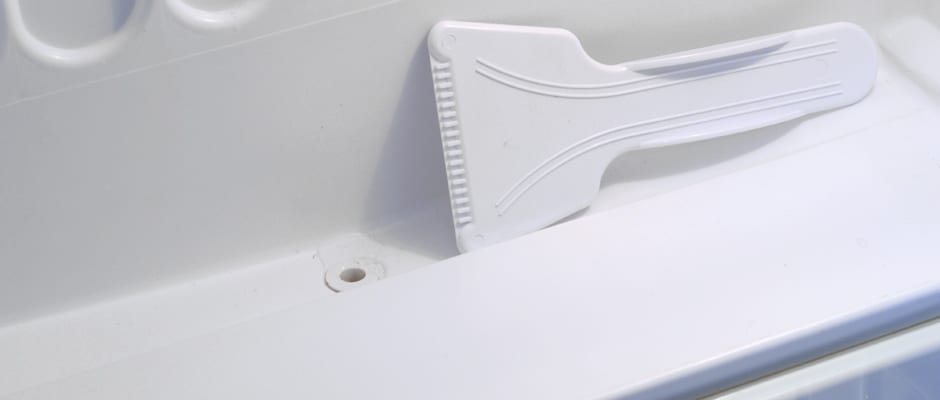Introduction
Design & Usability
Who knew cubes could be so floppy?
We've yet to meet a mini fridge that did much to improve on the standard boxy design, regardless of whether it's a one- or two-door model. This one gets two shelves in the main compartment, one of which is adjustable, and a tiny little "crisper" drawer. The fridge door has a can rack and two tiny shelves, one substantially taller than the other. The freezer is essentially an icebox, with the door boasting its own incredibly shallow shelf of dubious practicality.
No, the biggest issue we had didn’t have to do with layout or access. Rather, it had to do with stability, specifically of the glass shelves in the fridge. Nothing that was removable or adjustable in this fridge felt stable. The glass shelves in the fridge wiggled around any time we touched them. The drawer has no slot to hold it in place, and half the time it caught the front plastic edge of the shelf above it, pulling the shelf forward.
Cleaning is a pain, too. Door shelves have no lower guard, so anything that drips or spills will go everywhere. The fridge shelves have almost no spill containment save a removable plastic front edge. Add to that a control knob that's vaguely designed and a pain to get at and you've got yourself a product that's cheap even by mini-fridge standards.
{{photo_gallery "Front", "Handle", "Fingerprints", "Interior", "Fridge", "Controls", "Ice Scraper", "Crisper Drawer", "Fridge Door", "Freezer", "Freezer Door", "Side", "Back"}}
Performance & Features
A freezer in name only.
You'd think that something this small would be easy to cool. Not so: this Frigidaire mini fridge had temperature gaps that would make even a culinary anarchist cringe. The manual states that the control knob is preset to the manufacturer recommended setting, but we had to ignore that and crank the dial up to a much colder setting. Even after recalibrating, though, the fridge was still substantially warmer than it should have been. The top of the fridge—its coolest point—averaged 43 degrees, and it only got worse from there. The bottom of the fridge nearly broke 51 degrees, a completely unacceptable temperature.
The fridge strove to make up for that major flaw by remaining uncannily consistent over time. The freezer, however, could not make that claim. With a gap averaging six degrees from top to bottom (over a distance of just 7.5 inches, mind you), temperatures over time shifted almost a degree and a half. What does all this mean? Food goes in, freezer burn comes out.
The little drawer in the fridge was passable as a crisper, considering its lack of any sort of seal and no humidity control switch. Freezing times weren't as bad as we expected, but keep in mind that the temperature output set the performance bar pretty low. It doesn't take exponentially longer for a room temperature item to pass the freezing point on a thermostat—it just takes a really long time for that temperature to stabilize.
A Chilly Reception
This mini left us cold.
Sure, no mini fridge is going to be awesome, but Frigidaire's FFPH31M6LM is inefficient, inaccurate, and overpriced. The $299 MSRP is laughable, and the $200 sale price doesn't take away enough of the sting. There are plenty of other mini fridges—like this Danby, for instance—that cost less and do a job. They may not all have designated freezers, but when you've got one that's this bad, you might as well not have one at all. The Frigidaire gets points for being pretty big—the usable space is pretty close to the marketed storage capacity, more so than usual—but that space won't do you any good if it's not being cooled properly. Not even a Bud Light should be subjected to this sort of treatment; do your refreshments a favor and treat yourself to a better mini fridge.
Introduction
Sure, the specific performance points of a mini fridge aren't meant to be as dependable as a full-sized model, but folks who want an ice cold beer still want to make sure the thing works. Taking a closer look at the Frigidaire FFPH31M6LM mini fridge reveals some pretty disappointing flaws. Have a gander and judge for yourselves.
Temperature Performance
Ice, ice, our kingdom for some ice.
Smaller doesn't necessarily mean more easier, as is the case with the cooling abilities of this mini fridge. Despite cranking down the thermostat to well below the recommended manufacturer setting, the coolest this mini fridge's main compartment got was a balmy 43.42 degrees Fahrenheit. Get down the crisper drawer—less than a foot away—and you get temperatures averaging up to 50.9 degrees. Fortunately, temperature shift managed to stay down to a third of a degree or less over time, a small perk that should help if you don't care too much about how cold your refrigerated items are getting.
The freezer was just bad. There's no other way around it. Despite being just a few inches tall—7.5, to be exact—we saw a gap of about six degrees from top to bottom. Specifically, we observed an average of 7.97 at the top and 1.86 degrees at the bottom. What's worse is the fact that those sultry temperatures weren't even constant: standard deviation ranged from 0.51 degrees to a whopping 1.17, and that's after taking 36 hours to reach equilibrium. The day that sort of performance becomes acceptable is the day we throw in our reviewing towels and say the heck with it all.
{{photo_gallery "Fridge Temperature", "Fridge Temp Graph", "Freezer Temperature"}}
Moisture Retention
Sometimes below average will have to do.
With just below-average performance, the Frigidaire's lone drawer delivered some of the best performance of all. Losing an average of 0.22 grams of moisture per hour, this is actually on par with certain budget full-sized models. Considering the flimsy nature of this drawer's seal—lacking a proper berth, the drawer can slip around easily—and a complete lack of any humidity control, that's actually pretty impressive.
Freezing & Thawing
Who knew? One test it could actually pass.
Despite the long time it took for our test materials to reach a stable temperature in the freezer, initial freezing time was actually pretty acceptable. At one hour and 47 minutes, it's not great, but it is workable. We've seen large-scale fridges take over two hours, placing this mini not slightly off to the poorer side of average.
The insulation in the freezer of a mini fridge is laughable. If you leave the door open for a few seconds, it's going to start to thaw. As such, it was no surprise when this model failed to pass our power loss test. After unplugging this squat appliance, it took 29.94 hours (that's 29 hours and about 56 minutes, for those of you who are curious) for our materials to officially thaw. It's not the worst we've seen, but you may want to have some bags of ice handy for any power outage just incase.
{{photo_gallery "Freezing Graph", "Power Loss Graph"}}
Storage Space & Energy Efficiency
It's like a gremlin: small, but with a big appetite.
Marketed as a 3.1 cubic foot mini fridge, the amount of usable space here is actually pretty close to that. Two shelves and a drawer make up the fridge proper, with a can rack and two shelves on the door. In total—we measured the can rack as though it were a regular shelf—it adds up to 1.65 cubic feet of usable storage. The box-like freezer and its shallow door shelf add an additional 0.82 cubic feet of storage to the overall package.
{{photo_gallery "Fridge Storage", "Fridge Door Storage", "Freezer Storage", "Freezer Door Storage"}}
As is often the case with mini fridges, it's outrageously inefficient. Odds are good, though, that the product will keel over and die before you really see a huge long-term impact on your energy bill. Good thing, too, since it'll cost you an average of $19.22 per year at a rate of $0.09 per kWh. It may not seem like much, but it actually comes out to about 0.24 kWh per cubic foot of usable space. That's roughly three to four times the energy needed for a moderately efficient, full-sized fridge.
{{photo_gallery "Power Data"}}
Meet the tester
Matthew is a native of Brockton, MA and a graduate of Northeastern, where he earned a degree in English and Theatre. He has also studied at the Gaiety School of Acting in Dublin and spends most of his free time pursuing a performance career in the greater Boston area.
Checking our work.
Our team is here for one purpose: to help you buy the best stuff and love what you own. Our writers, editors, and lab technicians obsess over the products we cover to make sure you're confident and satisfied. Have a different opinion about something we recommend? Email us and we'll compare notes.
Shoot us an email


